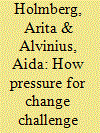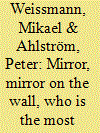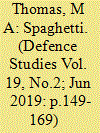|
|
|
Sort Order |
|
|
|
Items / Page
|
|
|
|
|
|
|
| Srl | Item |
| 1 |
ID:
165355


|
|
|
|
|
| Summary/Abstract |
This article elaborates on how structural, normative and functional pressures for change may challenge military organizational characteristics. We problematize theoretically and exemplify empirically what consequences these pressures can have on military organizational characteristics, arguing that they constitute major challenges for managing in particular normative pressures for change. The empirical examples suggest that bureaucratic, hierarchical, narcissistic and greedy traits of the organization are challenged by normative pressures such as value changes and normalization. Another source of challenge is professionalization processes. Structural challenges, on the other hand, are managed by the organization and do not seem to inhibit the workings of organizational characteristics. The plausibility probe conducted questions the sustainability of military organizational characteristics in their traditional disguise, in particular due to legitimacy concerns. It is suggested that future research should be directed towards analyzing how military organizations manage pressure for change and whether their characteristics are questioned.
|
|
|
|
|
|
|
|
|
|
|
|
|
|
|
|
| 2 |
ID:
165354


|
|
|
|
|
| Summary/Abstract |
The post-Cold War era has witnessed the rapid expansion of organisational learning initiatives within NATO militaries, especially formal “lessons-learned” processes. The effectiveness of national lessons-learned processes in recalibrating military activity to the demands of ongoing operations has been highly-differentiated. However, the academic literature on military change and practitioner guidance has been slow to investigate the key features of best-practice in military learning. This article breaks new ground by drawing upon the literature on dynamic organisational capabilities to explore the fundamental organisational processes and activities which are necessary to implement successful lessons-learned. It examines, in particular, the organisational features which facilitate “knowledge transformation”: the effective combination of new knowledge gained from intra- and inter-organisational learning with existing organisational knowledge. The article concludes by highlighting several potential future empirical and theoretical research agendas in military learning and the importance of engagement between lessons-learned practitioners and organisational learning scholars.
|
|
|
|
|
|
|
|
|
|
|
|
|
|
|
|
| 3 |
ID:
165357


|
|
|
|
|
| Summary/Abstract |
This article explores why the offensive predominates military tactical thinking. With survey results showing an offensive bias among 60 per cent of senior Swedish officers and as many as 80 per cent in the case of the army, it is clear that this is not just a problem of the past but is equally relevant today. The article asks why there is a tendency to perceive and understand offensive tactics as the preferred choice and the way to conduct battle that should be encouraged and preferred. Drawing on existing research and the findings of a pilot study, ten propositions for why the offensive bias exists are tested using a mixed-method approach. Based on the findings, the article develops a model to understand why the offensive dominates military tactical thinking. It is found that the two key constitutive factors behind the offensive bias are military culture and education. These factors most directly and profoundly influence an officer’s identity, perceptions, and thinking. Military culture and education, in turn, work as a prism for four other factors: military history, the theory and principles of war, doctrine and TTPs, and psychological factors.
|
|
|
|
|
|
|
|
|
|
|
|
|
|
|
|
| 4 |
ID:
165356


|
|
|
|
|
| Summary/Abstract |
In the mid-2000s, the United States Army was embroiled in counterinsurgency missions in Iraq and Afghanistan that required deeper understanding of local social systems. The Army turned to systems thinking and design thinking to model and understand the world, define problems, and develop approaches to strategic and operational challenges. However, the Army’s approach as expressed in publications and doctrine encourages the development of complicated, unsupported, and unfalsifiable hypotheses. The risk is that the Army will act on incorrect assumptions and develop plans that are fragile.
|
|
|
|
|
|
|
|
|
|
|
|
|
|
|
|
| 5 |
ID:
165358


|
|
|
|
|
| Summary/Abstract |
It has frequently been observed in the literature on hybrid wars that there is a grey zone between peace and war, and that hybrid wars are conflicts which are not clear cases of war. In this paper, I attempt to illuminate this grey zone and the concept and nature of war from the philosophical discussions of vagueness and institutional facts. Vague terms are characterized by the fact that there is no non-arbitrary boundary between entities which lie in their extension, and entities which do not lie in their extension. I apply a theory of vagueness to notions such as “war” and “peace” and go on to suggest that the exact boundary for what counts as a war or not is arbitrary. However, the context in which the conflict occurs determines a range of possible locations for this boundary. The most important contextual parameter is in this respect how the parties to the conflict themselves conceptualize the conflict. I suggest that this can in various ways help us understand grey-zone conflicts.
|
|
|
|
|
|
|
|
|
|
|
|
|
|
|
|
|
|
|
|
|